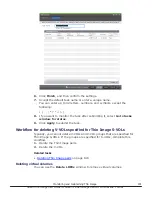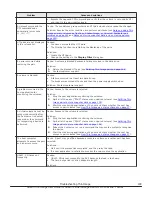
The pool capacity required for resolving SIMs is calculated as follows:
required-capacity = (capacity-used-by-pool / pool-threshold) -
pool-capacity-before-expansion
When you expand a pool using LDEVs created from parity groups of which
accelerated compression is enabled, the total amount of the LDEVs should
meet the following conditions:
total-capacity-of-LDEVs-to-be-created ≤ (physical-amount-of-
parity-group / (1 –deletion-rate)) –
- capacity-of-pool-volumes-belonging-to-applicable-parity-group-
of-pool-before-expansion
Determine whether to expand a pool by comparing the results calculated by
using the above formulas.
When
required-capacity ≤ total-capacity-of-LDEVs-to-be-created
The insufficient capacity can be reserved by using the available capacity in a
parity group of which accelerated compression is enabled.
When
required-capacity > total-capacity-of-LDEVs-to-be-created
To reserve the insufficient capacity, add a parity group to create an LDEV, and
then expand the pool.
Note that the threshold and the deletion rate used for the calculation are
expressed as a fraction converted from a percent. For example, if the
threshold is 80%, enter 80/100 as the pool threshold for the calculation.
Workflow to perform when SIMs related to the capacity ensured for writing
were reported
The following figures explain how to take action when 604xxx, 605xxx, or
606xxx has occurred.
204
Troubleshooting Thin Image
Hitachi Thin Image User Guide for Hitachi Virtual Storage Platform G Series and F Series
















































